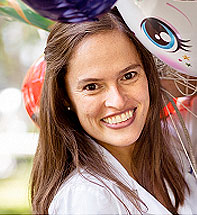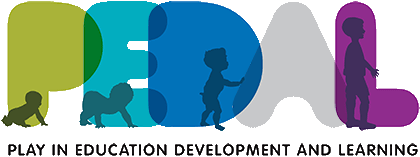A translation of this article in Spanish is available to download here.
Si deseas leer este artículo en Español, da clic aquí.
I left my country, and my job as a clinical paediatrician, back in 2019. I was full of questions and a huge desire to improve the way we communicate and interact with children in hospitals. My main goal was to continue to improve the lives of sick children by conducting research and being able to help more than one child at a time. My objective is to create change and leave the world, specifically the world of paediatric medicine, a little better than I found it.
The mission started with a Master’s in Medical Anthropology at University College London (UCL). On hearing that I wanted to focus on child-friendly paediatric practices, a colleague asked if I had heard about ‘Health Play Specialists’. Fascinated by this newly acquired knowledge, I went ‘down the rabbit hole’ and focused my research on the role of Health Play Specialists and the value they bring to paediatric healthcare settings.
Through the medium of play, Health Play Specialists interact with hospitalised children to provide emotional support, create time and space for play opportunities and impart child-friendly information regarding each patient’s individual healthcare journey.
There is an important difference between Health Play Specialists and Play Therapists. The latter are specially trained mental health practitioners who “help children express their feelings and deal with their emotional problems, using play as the main tool of communication.”
My doctoral research here at PEDAL focuses on children’s perspectives regarding their interactions with Health Play Specialists during their hospitalisation. I really hope that this research will capture children’s voices and generate new knowledge that can be incorporated into the education and training of paediatric healthcare professionals.
Before starting my field work (data collection), I need to understand as much as I can about the role of Health Play Specialists. During field work, I will be observing hospitalised children’s interactions with Health Play Specialists and having conversations with patients to capture what they think about the role of these professionals.
I decided I needed to get moving, stop reviewing the literature and head out on an adventure to immerse myself, with all my senses, in the world of ‘play and health’ and meet Health Play Specialists. I wanted to understand their role, the way they are trained and how they work, not only within the UK but also globally (where these professionals are known by other names such as Child-Life Specialists, Child Play Specialists, Child-Life Therapists etc.)
My approach toward a global understanding of the role of Health Play Specialists was enhanced back in 2020, when I started volunteering for Paediatric Potential Inc. – an American non-profit organisation that provides training and support in multiple countries (including Laos, Kuwait, and India) to promote psychosocial care and child-friendly practices, whilst respecting the diversity of each sociocultural context. Through my role with Paediatric Potential Inc., my research at PEDAL and my public engagement project Semana JIM®, I have created a vast network of professionals who help me to explore the use of hospital specialised play in different places.
In Barcelona, I had the opportunity to meet and learn from Carmen Jerez. She is the Director of the Master’s in Emotional Care for Hospitalised Children according to the Child-Life Model, at the University of Barcelona. The students who graduate from this programme work at the Hospital Sant Joan de Déu. During my visit to the hospital, the Child-Life Specialists shared how their team is constantly looking for innovative ways to humanise paediatric care, with the support of the hospital authorities and members of the Quality of Care and Patient Experience Unit. In the same hospital, Jennifer MacIntosh, from the European Children’s Hospitals Organisation (ECHO), showed me the playful environment that has been created for patients and their families. Beyond the hospital, I met with the creator and team members of Nixi for Children, an innovative company that utilises virtual reality to reduce anxiety in paediatric patients. They achieve this by providing children with virtual tours of hospitals, operating rooms and radiotherapy machines before their hospital visits to help familiarise the often unpredictable and sometimes scary hospital environment.
In Australia, the Association of Child-Life Therapists Australia (ACLTA) helped me to connect with, and visit, two Play Teams in New South Wales. During my short but fruitful visit, I learned some of the similarities and differences in play in hospitals between different countries. While visiting John Hunter Children’s Hospital and Sydney Children’s Hospital, Randwick, my attention was captured by the many initiatives that these teams have, which are devoted not only to caring for children, but also for teenage patients. Michelle Perrin and Janet Burke, the Play Leaders at each of these hospitals, taught me more about recent literature on the topic, the multimedia material that has been created by the Royal Children’s Hospital Melbourne (B Positive), and their fun initiative titled ‘Party Day’ (which you can view by clicking this link.)
As a researcher now based in the UK, I’ve been able to spend some time as a Play Student at the Great Ormond Street Children’s Hospital (GOSH). By shadowing different members of the Play Team, I’ve been taken on an eye-opening, wild ride of proactivity, creativity and child-friendly practices. I’ve witnessed things that, as a paediatrician, I would never have imagined possible, such as playing with water in the Paediatric Intensive Care Unit (PICU) and a young patient evaluating which could be the most appropriate anaesthetic mask for her teddy bear’s face before sedation. Through my conversations with the GOSH Play Team, my understanding of their role and the reasoning behind their approach to each child has increased and prepared me to start my field work in the coming weeks.
Through all these global adventures, I have learned a lot. One thing is very clear: the job that Health Play Specialists do in hospitals needs to be very spontaneous. They must use all their skills, creativity and training to respond to each child’s needs and to adapt to every situation. Here at PEDAL, as a team of ‘play researchers’, we know that one of the beauties of play is how spontaneous and unpredictable it can be. I am deeply aware that one of the challenges for me, as a play and health researcher (or explorer), will be to capture the synergetic power of two very unpredictable things: play and children’s hospitals. I cannot wait to start my field work and see, after all this learning about Health Play Specialists, what children have to say about their interactions with these playful professionals.
To find out more about Paulina’s work as part of the Play in Health team, please click here.

Additional Reading
Learn more about the world of Health Play Specialists and the use of play in healthcare settings using the resources below:
- Celebrating International Play Therapy Week: What is Play Therapy? (Conroy, 2023)
- Play in Hospitals: Real Life Perspectives (Everett et al., 2023)
- Handbook of research on play specialism strategies to prevent paediatric hospitalisation trauma (Perasso & Ozturk, 2022)

Paulina Pérez-Duarte Mendiola
PEDAL PhD Student

